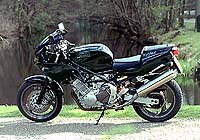Church of MO: 1996 Yamaha TRX850
Twenty-five years ago, Yamaha had an 849 cc liquid-cooled 270-degree cranked parallel Twin in a steel birdcage frame, but the TRX850 faded from view before it even made it to America. Today, 270-degree parallel Twins and trellis frames are all the rage. All things are wearisome, more than one can say. The eye never has enough of seeing, nor the ear its fill of hearing. What has been will be again, what has been done will be done again; there is nothing new under the sun.
Japan’s Other Twin
Lately, it seems all motorcycle journalists having been driving themselves crazy trying to decide if Honda or Suzuki have finally toppled Ducati’s 916 from it’s place as Ultimate Sport-Twin Superbike, and little attention is paid to the other Japanese twin. Rightly so, as the Yamaha TRX850 was never designed to compete head on with the 916, as Honda’s VTR1000 and Suzuki’s TL1000 were. You can’t even buy it in red (in Europe).But it was clearly the pre-916, two-valve Ducatis that Yamaha was aiming at when their first prototype versions were unveiled in the summer of 1995. The TRX’s trellis frame tubing had been one of the Italian company’s trademarks — and a feature they’ve chosen to retain despite the fashion for twin-spar beam frames. The five-valve parallel-twin engine of the Yamaha has a 270 degree crankshaft that gives it the lumpy sound and feel of a V-twin. Twist the throttle open and you’d swear it was a Ducati rumbling through the rough spot from 3,000 to 5,000 rpm. Above that engine speed, a crank balancer
smoothes out engine vibration as it flies up to, and beyond, the 8,000 rpm redline. It’s just as well Yamaha’s 5-valve engines are so ultra strong, as its rev limiter lets the bike happily spin past 9,000 and right off the tach before cutting in. With a maximum power of 76 bhp produced at 7,500 rpm, though, there’s no point revving the guts out of a TRX. Yamaha’s TRX shares its engine and 5-speed gearbox with the 1996 TDM850, a simple way to reduce the costs of introducing two new models. The TDM had a very noisy gearbox that would turn heads at each change in the first two gears. In contrast, the TRX gearbox is quite slick, although there are still a few false neutrals hiding in there waiting for careless gear changes.
Like a Ducati, you can pick a line through a corner on the TRX and the bike will hold it. While it’s good practice to power through corners on any bike, this is especially true for the TRX; getting on the throttle at engine speeds under 4,000 rpm will cause the bike to lurch as power surges through its drive train.
This machine seems happiest with its engine spinning above 5,000 rpm. Cruising at legal European motorway speeds in top gear has the big twin running at 4,000 rpm, where it feels lumpy and just off its powerband. But out where country roads get twisty, the TRX comes into its element. It’s almost as much fun winding open the throttle coming out of corners and listening to that big twin exhaust note as it is strafing apexes. Then squeal its brakes coming into the next bend and do it all over again.
Also, the TRX is known to be a little sensitive to tires, but the Metzeler Z1s that were fitted to our test bike are considered to be some of the best. The front was perfect, warming well and providing a lot of confidence despite the rather soft front forks. Yamaha seems to have a strategy for consistently fitting good brakes to their recent models, and the TRX is no exception. The linear relationship between a couple fingers on the lever and applied braking force was only spoiled by its soft front forks diving towards the road as the brakes bit down. With spring preload and rebound damping the only external adjustments, different fluids offer the only option for dialing-in front end compression damping to fight the dive. Around back, the TRX’s single shock has full adjustability and worked well.
Will Yamaha’s TRX survive the arrival of killer twins from Honda and Suzuki? It deserves to, as we found it a lot of fun to ride despite the 30-odd horsepower deficit. Maybe it’s that deficit that makes it so enjoyable, as the engine never seems intimidating. You don’t see many TRXs on the road and sales have not been spectacular, despite the low price. With rumors that Yamaha has their own V-twin under development in a back room in Japan, the TRX’s days may be numbered. If so, and it does disappear within a couple of years, it will certainly become a cult bike with a dedicated, fanatical group of owners, proud to possess a uniquely different motorcycle.
Specifications:
Manufacturer: Yamaha Model: 1996 TRX 850 (Unchanged for 1997) Dutch Price: Fl. 19,995 ($10,800 U.S.) Engine: Liquid-cooled, DOHC, 5-valve Twin-cylinder Bore x stroke: 89.5 x 67.5 mm Displacement: 849 cc Carburation: Mikuni BDST38/2 Transmission: 5-speed Wheelbase: 1435 mm Seat Height: 795 mm Fuel Capacity: 18 L Claimed dry Weight: 190 Kg (418 lbs)
More by John Burns































Comments
Join the conversation
Just bought a TRX850 JDM spec - looking forward to the ride.
https://www.facebook.com/gr...